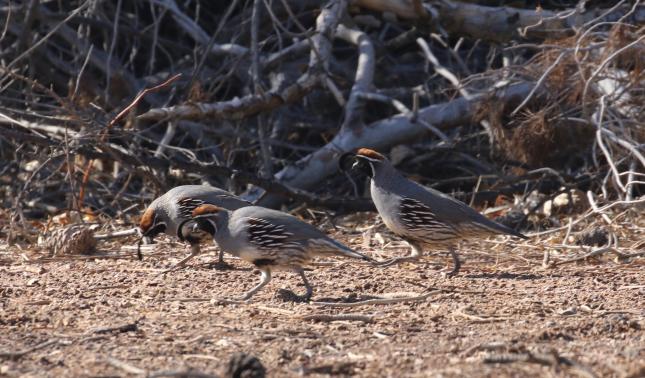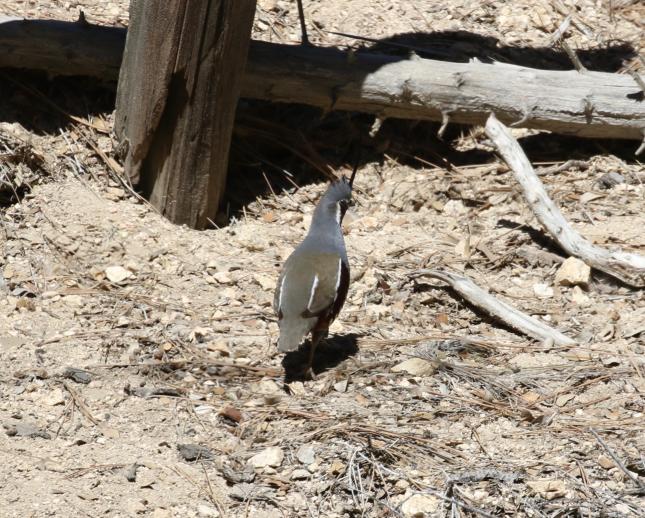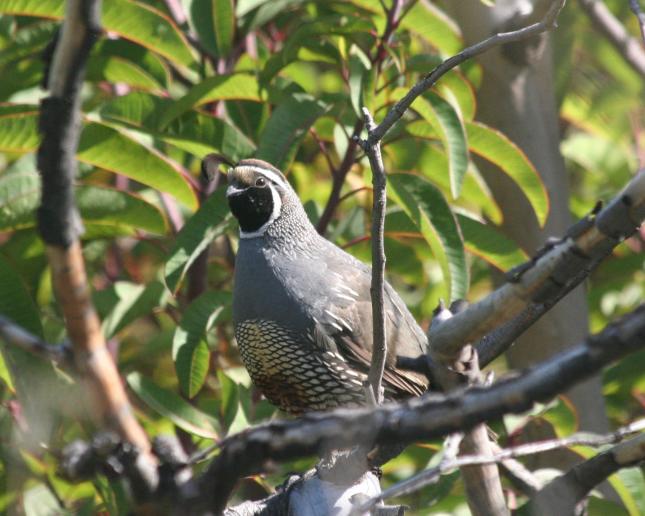Fun Facts about Quail
The only quail that we expect to see in the Conejo Valley is the California Quail. However if you travel to our local mountains or desert areas you may be fortunate to encounter Mountain or Gambel's Quail. Here are some fun facts about these species.
California Quail
- California Quail are plump, short-necked game birds with a small head and bill. They fly on short, very broad wings. The tail is fairly long and square. Both sexes have a comma-shaped topknot of feathers projecting forward from the forehead, longer in males than females.
- You’ll find California Quail in chaparral, sagebrush, oak woodlands, and foothill forests of California and the Northwest. They’re quite tolerant of people and can be common in city parks, suburban gardens, and agricultural areas.
- Pairs of California Quail call antiphonally, meaning that the male and female alternate calls, fitting their calls into a tightly orchestrated pattern.
- The California Quail’s head plume, or topknot, looks like a single feather, but it is actually a cluster of six overlapping feathers.
- As an adaptation to living in arid environments, California Quails can often get by without water, acquiring their moisture from insects and succulent vegetation. During periods of sustained heat they must find drinking water to survive.
- The California Quail digests vegetation with the help of protozoans in its intestine. Chicks acquire the protozoans by pecking at the feces of adults.
Gambel's Quail
 Gambel’s Quail are gregarious birds of the desert Southwest, where coveys gather along brushy washes and cactus-studded arroyos to feed. Males and females both sport a bobbing black topknot of feathers. The male’s prominent black belly patch distinguishes it from the similar California Quail.
Gambel’s Quail are gregarious birds of the desert Southwest, where coveys gather along brushy washes and cactus-studded arroyos to feed. Males and females both sport a bobbing black topknot of feathers. The male’s prominent black belly patch distinguishes it from the similar California Quail.- Just before her eggs hatch, the female Gambel’s Quail calls to the chicks, who cheep to each other from inside the eggs. The eggs hatch in synchrony, with the chick cutting a neat hole in the largest part of the shell and leaving an intact piece of membrane to serve as a “hinge” — the chick pushes on the shell and opens the “door” that it has created.
Mountain Quail

- A plump bird patterned in gray, white, and chestnut, the Mountain Quail sports a dramatic head plume like an exclamation point on its head. It is an elusive bird of western scrub and highlands—easy to hear but difficult to see. The species inhabits remote mountainous areas typically covered with dense shrubs such as chaparral.
- The Mountain Quail is the largest quail in the United States.
- The Mountain Quail’s long head plume gives a clue to its attitude. When the plume is angled backward, the bird is typically relaxed, feeding or resting, like a dog with its ears down. When the plume sticks straight up, the bird is agitated or alert.


